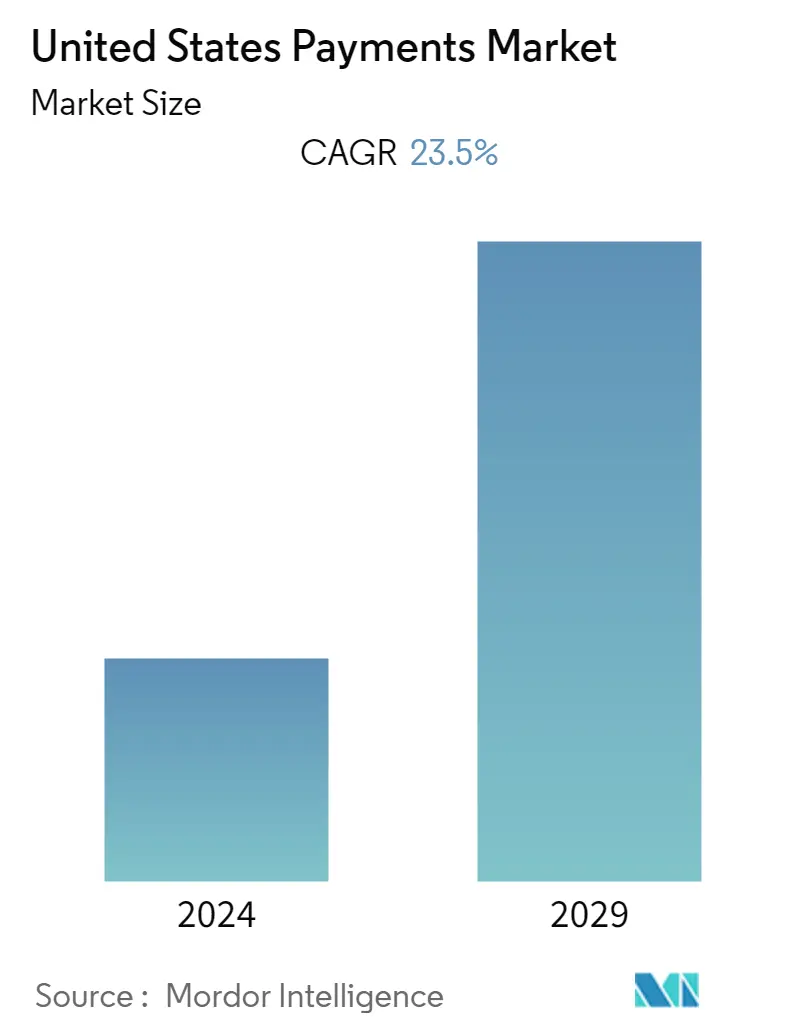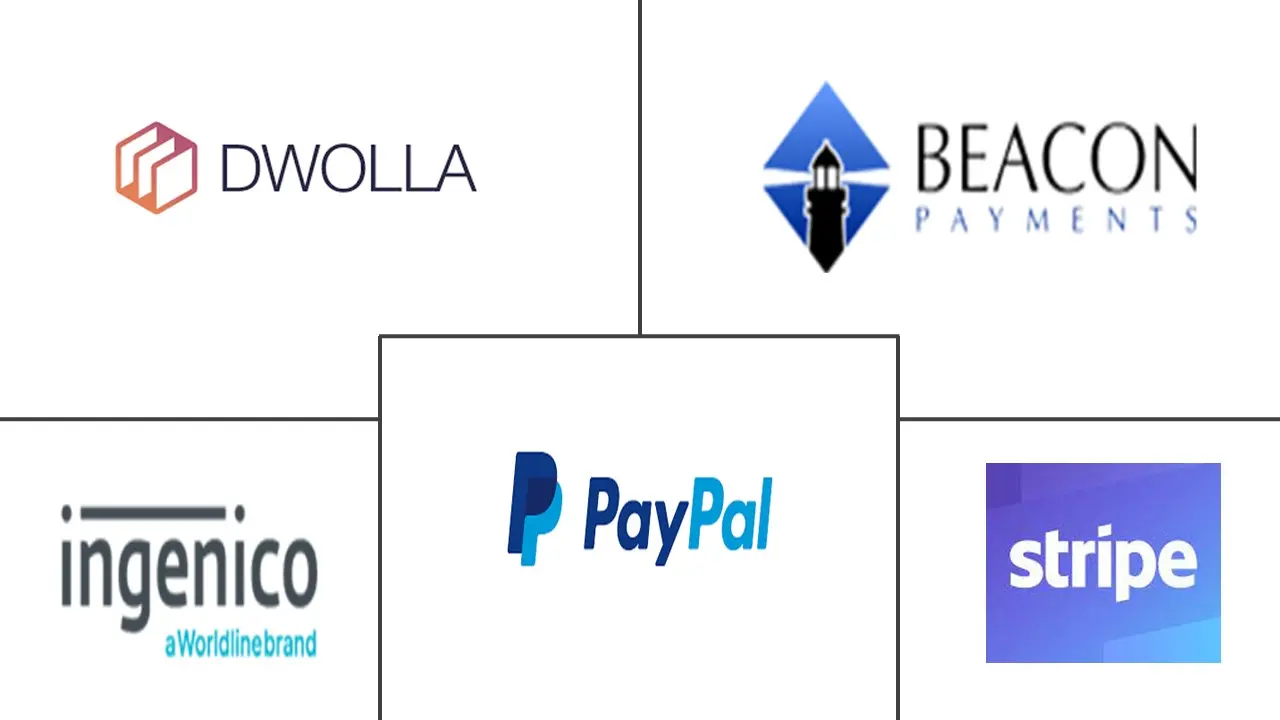Market Size of United States Payments Industry

| Study Period | 2019 - 2029 |
| Base Year For Estimation | 2023 |
| Forecast Data Period | 2024 - 2029 |
| Historical Data Period | 2019 - 2022 |
| CAGR | 23.50 % |
| Market Concentration | High |
Major Players
*Disclaimer: Major Players sorted in no particular order |
US Payment Market Analysis
The development of the United States payment market was influenced by various different factors, including the rise of e-commerce, inclination towards online payments, and other factors. Many financial intermediaries offer payment and clearing services. Private payment systems include local interbank associations cashing member checks and operating automated teller machines (ATMs) and POS networks to nationwide credit and debit card networks. The size and complexity of US financial markets have led to significant interdependence of payments and settlements. The market is expected to grow at a CAGR of 23.5% during the forecast period (2022 - 2027).
- The US payment system connects different financial institutions, households, and businesses. Most payments in the United States rely on interbank payment services such as the ACH network and wire transfer systems to transfer money from one bank's sender's account to another bank's recipient's account. Therefore, interbank payment services are essential to the functioning and stability of the financial system and the economy in general.
- Recent improvements to the United States payment system have focused on making payments faster, cheaper, more convenient, and more accessible. "Instant" payments are a particularly active private and public innovation area. The Federal Reserve is also scheduled to launch in 2023, building a new interbank payment service, FedNow Service, for instant payments. These instant payment services will allow commercial banks to provide households and businesses with 24/7 payment services, giving recipients quick access to the funds transferred.
- The United States e-commerce market is noteworthy for its high level of adoption, with 78% of US citizens already shopping online. The dominance of domestic online giants such as Amazon, eBay, and Apple are the country's three significant merchants. Amazon alone accounts for nearly 50% of all e-commerce sales in the United States. Further, other major domestic retail brands are investing heavily in digital products.
- Moreover, existing payment systems are generally effective and efficient but have specific challenges. In particular, quite a few Americans currently do not have access to digital banking and payment services. In addition, some payments-especially cross-border payments, will continue to remain slow and costly.
- Due to the outbreak of coronavirus, the country witnessed a lockdown that compelled people to switch to online shopping and online payments. This has significantly boosted the growth of the United States Payments market.
US Payment Industry Segmentation
The US payments market includes various types of payments, including point-of-sale, e-commerce, card payments, and contactless payments. E-commerce payments include online purchases of goods and services. Shop on e-commerce sites and book travel and accommodation online. For POS, all transactions made on physical sales are within the market range of credit or debit card payments. This includes all face-to-face transactions, not just traditional in-store transactions, regardless of location. In both cases, cash payments are also an option for e-commerce sales.
| By Mode of Payment | ||||||
| ||||||
|
| By End-user Industry | |
| Retail | |
| Entertainment | |
| Healthcare | |
| Hospitality | |
| Other End-user Industries |
United States Payments Market Size Summary
The United States payment market is experiencing significant transformation driven by the rise of e-commerce and a shift towards online payments. This evolution is supported by a robust infrastructure of financial intermediaries offering various payment and clearing services, including interbank networks like ACH and wire transfer systems. The market's complexity and size have fostered a high degree of interdependence among payment and settlement systems, which are crucial for the stability of the financial ecosystem. Recent advancements aim to enhance the speed, cost-effectiveness, and accessibility of payment services, with innovations such as instant payment systems gaining traction. The introduction of the FedNow Service by the Federal Reserve is a notable development, promising 24/7 payment capabilities for commercial banks, thereby facilitating quicker access to funds for consumers and businesses alike.
The growth of the US payment market is further propelled by the increasing adoption of digital and mobile payment solutions, reflecting changing consumer behaviors towards cashless transactions. The proliferation of smartphones, particularly those operating on Android and iOS, has contributed to this trend, with major retailers and e-commerce platforms integrating contactless payment options like Apple Pay. Despite the effectiveness of existing systems, challenges remain, such as limited access to digital banking for some Americans and the high costs of cross-border payments. The competitive landscape is marked by strategic partnerships and investments by key players like Stripe, PayPal, and Global Payments, who are continuously developing new solutions to cater to the evolving needs of the market. These efforts are aimed at enhancing the digital payment experience, thereby supporting the ongoing growth of e-commerce in the United States.
United States Payments Market Size - Table of Contents
-
1. MARKET INSIGHTS
-
1.1 Market Overview
-
1.2 Industry Stakeholder Analysis
-
1.3 Industry Attractiveness-Porter's Five Force Analysis
-
1.3.1 Bargaining Power of Suppliers
-
1.3.2 Bargaining Power of Buyers/Consumers
-
1.3.3 Threat of New Entrants
-
1.3.4 Threat of Substitute Products
-
1.3.5 Intensity of Competitive Rivalry
-
-
1.4 Evolution of the payments landscape in the country
-
1.5 Key market trends pertaining to the growth of cashless transaction in the country
-
1.6 Impact of COVID-19 on the payments market in the country
-
-
2. Market Segmentation
-
2.1 By Mode of Payment
-
2.1.1 Point of Sale
-
2.1.1.1 Card Payments (includes Debit Cards, Credit Cards, Bank Financing Prepaid Cards)
-
2.1.1.2 Digital Wallet (includes Mobile Wallets)
-
2.1.1.3 Cash
-
2.1.1.4 Others
-
-
2.1.2 Online Sale
-
2.1.2.1 Card Payments (includes Debit Cards, Credit Cards, Bank Financing Prepaid Cards)
-
2.1.2.2 Digital Wallet (includes Mobile Wallets)
-
2.1.2.3 Others (includes Cash on Delivery, Bank Transfer, and Buy Now, Pay Later)
-
-
-
2.2 By End-user Industry
-
2.2.1 Retail
-
2.2.2 Entertainment
-
2.2.3 Healthcare
-
2.2.4 Hospitality
-
2.2.5 Other End-user Industries
-
-
United States Payments Market Size FAQs
What is the current United States Payments Market size?
The United States Payments Market is projected to register a CAGR of 23.5% during the forecast period (2024-2029)
Who are the key players in United States Payments Market?
Dwolla, PayPal, Stripe, Inc., Ingenico and Beacon Payments LLC are the major companies operating in the United States Payments Market.

